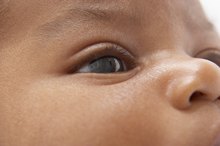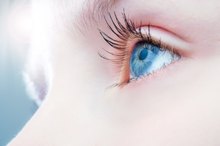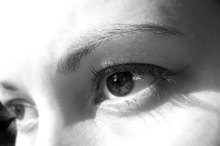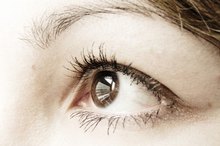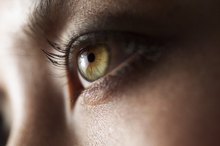Eye Growth From Childhood to Adulthood
The human eye grows very little from birth to adulthood, but even small errors in its proportion can cause vision problems. Vision involves both the ability of the eye to capture images and the ability of the brain to process the signals that the eye sends. Vision deficiencies may be a result of problems from either function. Children born prematurely or with a family history of eye problems are at greater risk of developing eye health issues.
If you are experiencing serious medical symptoms, seek emergency treatment immediately.
Size
A newborn’s eye measures about .7 inches from front to back--approximately 70 percent of the size of an adult’s eye. This is why babies' eyes seem large in proportion to their heads. During infancy, the eyeball grows just 1 millimeter, to a length of about .74 inches. The eye continues to grow gradually throughout childhood until it reaches a length of about 1 inch in adulthood 1. The protective skull cavity where the eyeball rests, sometimes called the eye socket, grows along with the eyeball.
- A newborn’s eye measures about.7 inches from front to back--approximately 70 percent of the size of an adult’s eye.
Optical Errors
Extra Skin Folds & Eye Problems in Infants
Learn More
As the eyeball grows, changes in its shape may cause errors in the focal point inside the eye. If the eye is too short in length, the focal point for images will fall behind the retina and your child will experience hyperopia, or far-sightedness. The resultant blurry image may cause headaches, eye strain or fatigue. If you notice your child squinting or rubbing his eyes, or if he complains of difficultly in reading, he may have hyperopia. Conversely, if the eyeball grows disproportionally long, the focal point will fall short of the retina and your child will not be able to see distant objects. This condition is myopia, or near-sightedness. It too may cause headaches, eye strain and squinting.
- As the eyeball grows, changes in its shape may cause errors in the focal point inside the eye.
- If the eye is too short in length, the focal point for images will fall behind the retina and your child will experience hyperopia, or far-sightedness.
Strabismus
If your child’s eyes are not properly positioned or if the length of the eye is not proportional, one or both of her eyes may become misaligned and she may be unable to track movement. This condition, called strabismus, may interfere with depth perception and can lead to reading disabilities. It also can lead to amblyopia, a condition in which the brain does not receive matching images from the two eyes that it can fuse into a single stereo image. This condition may cause vision loss.
- If your child’s eyes are not properly positioned or if the length of the eye is not proportional, one or both of her eyes may become misaligned and she may be unable to track movement.
- This condition, called strabismus, may interfere with depth perception and can lead to reading disabilities.
Prematurity
Visual Perception Problems in Children
Learn More
The formation of the eye’s blood vessels takes a full 40 weeks from conception, so a baby who is born prematurely does not yet have the full network of blood vessels necessary to support the eyes’ needs. In some cases, the formation of blood vessels becomes erratic and excessive after birth. This condition is called retinopathy of prematurity. Blood vessels may proliferate in the retina and may even form in the vitreous space, which should be devoid of veins and arteries. These abnormal vessels may leak, and then contract, which can detach or distort the retina, and vision loss or blindness may result. In severe cases, membranes may form behind the lens and block the passage of light to the retina.
- The formation of the eye’s blood vessels takes a full 40 weeks from conception, so a baby who is born prematurely does not yet have the full network of blood vessels necessary to support the eyes’ needs.
- Blood vessels may proliferate in the retina and may even form in the vitreous space, which should be devoid of veins and arteries.
Eye Examinations
Eye examinations help to detect and correct problems that may arise as your child’s eyes develop. Children's Vision Information Network recommends that your child have his first eye exam by age 3, or sooner if vision problems run in your family or your spouse’s. He should have another complete eye exam before entering school to ensure that his eyes are ready to handle the stress of close work, such as reading and mathematics. Preschool children use their eyes mainly for distance, and problems with close-range vision may not be obvious without a thorough eye exam. Although schools conduct testing using eye charts, this perfunctory type of exam does not reveal other issues, such as difficulty using the eyes together for prolonged periods of time, or tracking a line of print, or the overall health of your child’s eyes.
- Eye examinations help to detect and correct problems that may arise as your child’s eyes develop.
- Although schools conduct testing using eye charts, this perfunctory type of exam does not reveal other issues, such as difficulty using the eyes together for prolonged periods of time, or tracking a line of print, or the overall health of your child’s eyes.
Related Articles
References
Writer Bio
A retired federal senior executive currently working as a management consultant and communications expert, Mary Bauer has written and edited for senior U.S. government audiences, including the White House, since 1984. She holds a Master of Arts in French from George Mason University and a Bachelor of Arts in English, French and international relations from Aquinas College.


